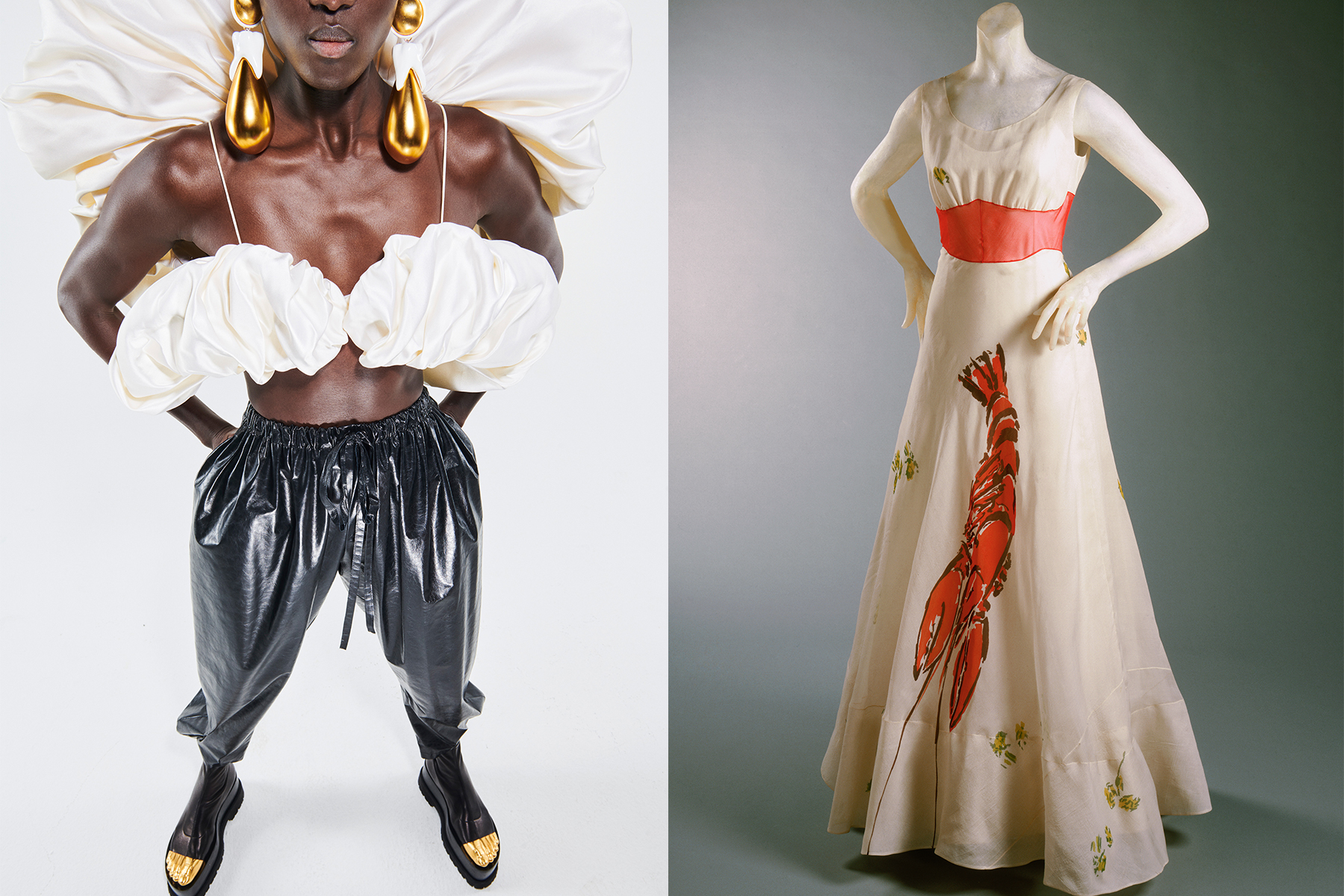How Elsa Schiaparelli’s surrealist roots created one of fashion’s most innovative houses.
Among the infamous social circles that have emerged throughout artistic history, from the clique of Café Guerbois to the Antwerp Six, one of the most indelible artistic friendships to form was that of Elsa Schiaparelli and Salvador Dalí. The Italian fashion designer and Spanish surrealist painter collaborated throughout the 1930s and ’40s on various projects and garments, thus giving rise to the surrealist Schiaparelli designs we know and love today.
“There was a general flow of creative energy around Schiaparelli and the surrealists,” explains Nancy Deihl, Chair of the Department of Art and Art Professions at NYU, and resident Schiaparelli expert. “Photos of her designs were included in surrealist texts and journals, and she appeared in surrealist photos by Man Ray, a noted photographer. In addition, women artists working in surrealism–and wives and companions of male surrealists–eagerly wore Schiaparelli’s creations.”
At its core, what is Schiaparelli without its signature surrealist quality? From the ineradicable Lobster Dress, which, based off of Dalí’s own lobster telephones, paved the way for Ms. Schiaparelli’s rise to fashion prominence, to the garish gold-plated accessories of the recent Spring 2021 Couture collection, the brand’s luxury creations are served with a finish of non-sequitur glamour. These surreal fashion moments are always welcome; in a market washed away in Gore-Tex and vinyl, sometimes audiences need a gold-plated baby feeding off an iridescent breast to shock them back to life.
One thing to note about Schiaparelli, and especially its founder, is that neither seem to be interested in what the others are doing. Even dating back to the mid-war era, in which Elsa Schiaparelli found herself pitted against Coco Chanel as her main competition, the garments created by the two couturiers “displayed very different approaches toward fashion design,” according to Deihl. “Unlike Chanel, who was very open about being influenced by menswear, Schiaparelli celebrated art and was inspired by working directly with materials. She was enthusiastic about the performing arts, astrology, music, but also new fabric technologies. It was said that Chanel thought of fashion design as an extension of dressmaking, but Schiaparelli saw it as an art.”
In an era of proper dress, kissing faces beaded on the back of an evening gown (designed in collaboration with surrealist legend Jean Cocteau) and enamel skeleton bones protruding harmoniously from a silk crepe evening gown helped the couturier make a name for herself.

Schiaparelli is responsible for a host of other notable designs, including the trompe-l’œil Tears Dress, a delicate pristine white asymmetrical-shouldered gown and matching veil, adorned with a hot pink print mimicking tears in the dress’s fabric. Then again in 1937, Dalí and Schiaparelli collaborated to create the Shoe Hat, offering another dose of campy fun to the high society circle that sported her designs.
Following World War II, Dior’s New Look eradicated the austere floor length stylings of the ’30s and ’40s, and with it, Schiaparelli’s business. The House of Schiaparelli shut down in 1954 as the world marched forward on its path beyond tremulous times.
It wasn’t until 2013 that it was announced that the house of Schiaparelli would re-emerge under the creative direction of Marco Zanini. Soaring into the 2010s, the brand returned with its signature surrealist style, this time outfitted to contemporary mode. While the brand did not disappoint, it’s not until recently that they hit their stride. Under the creative direction of Daniel Roseberry, the house has produced designs reminiscent of the keystone Schiaparelli garments, including a floor-length gown inspired by the Skeleton Dress and a junket of luxurious anthropomorphic jewelry dripping in gold.
Schiaparelli continues to, as it did in wartime Europe, find its way into high-profile celebrity circles, most recently that of reality television’s most infamous family. A custom Schiaparelli gown was Kim Kardashian’s choice of attire this past Christmas, the dress featuring a chiseled leather bustier and luxurious lime green satin skirt. While internet pundits were quick to poke fun at Kim’s jaguar-green enamel abdomen, the ensemble packed a surrealist punch that left people talking.
As the House of Schiaparelli presents its Fall/Winter 2021 Ready-to-Wear collection today at Paris Fashion Week, we’re left to watch what the house’s next move is, and how closely they’ll stick to their founder’s roots. “Schiaparelli has a significant aesthetic heritage that should be seen as a great asset,” explains Deihl in regards to what she sees in Schiaparelli’s future. “That is to say that there would be no point in encouraging a retro or revivalist aesthetic, but the spirit of exploration and humor are fundamental to the spirit of Schiaparelli and hopefully the brand will continue that legacy as a distinction.”.
Image credit: Schiaparelli/Philadelphia Museum of Art: Gift of Mme Elsa Schiaparelli, 1969, 1969-232-52




